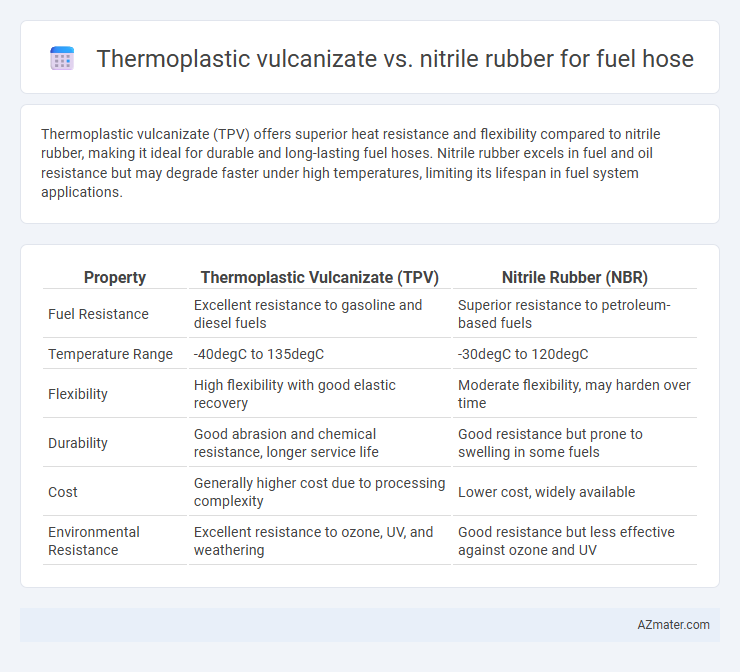Thermoplastic vulcanizate (TPV) offers superior heat resistance and flexibility compared to nitrile rubber, making it ideal for durable and long-lasting fuel hoses. Nitrile rubber excels in fuel and oil resistance but may degrade faster under high temperatures, limiting its lifespan in fuel system applications.
Table of Comparison
| Property | Thermoplastic Vulcanizate (TPV) | Nitrile Rubber (NBR) |
|---|---|---|
| Fuel Resistance | Excellent resistance to gasoline and diesel fuels | Superior resistance to petroleum-based fuels |
| Temperature Range | -40degC to 135degC | -30degC to 120degC |
| Flexibility | High flexibility with good elastic recovery | Moderate flexibility, may harden over time |
| Durability | Good abrasion and chemical resistance, longer service life | Good resistance but prone to swelling in some fuels |
| Cost | Generally higher cost due to processing complexity | Lower cost, widely available |
| Environmental Resistance | Excellent resistance to ozone, UV, and weathering | Good resistance but less effective against ozone and UV |
Introduction to Fuel Hose Materials
Thermoplastic vulcanizate (TPV) and nitrile rubber (NBR) are widely used materials in fuel hose manufacturing, each offering unique advantages in chemical resistance and flexibility. TPV provides excellent resistance to fuels, oils, and environmental stress cracking while maintaining superior flexibility at low temperatures. Nitrile rubber excels in fuel permeability resistance and overall durability, making it suitable for high-performance fuel hoses exposed to harsh conditions.
Overview of Thermoplastic Vulcanizate (TPV)
Thermoplastic Vulcanizate (TPV) is a high-performance elastomer combining the flexibility and resilience of vulcanized rubber with the processability of thermoplastics, making it ideal for fuel hose applications. TPV offers superior chemical resistance, especially against fuels and oils, and excellent thermal stability, maintaining flexibility across a wide temperature range from -40degC to 150degC. Its lightweight, durability, and recyclability distinguish TPV from conventional Nitrile Rubber (NBR), which, while cost-effective, generally exhibits lower heat resistance and less environmental sustainability.
Key Properties of Nitrile Rubber (NBR)
Nitrile Rubber (NBR) is highly valued for fuel hoses due to its exceptional resistance to gasoline, oils, and other hydrocarbons, ensuring durability in harsh fuel environments. It offers excellent tensile strength, abrasion resistance, and low gas permeability, which are critical for maintaining hose integrity and preventing leaks. Thermal stability ranging from -40degC to 120degC enables NBR fuel hoses to perform reliably under varying temperature conditions.
Chemical Resistance in Fuel Systems
Thermoplastic vulcanizate (TPV) exhibits superior chemical resistance in fuel systems compared to nitrile rubber, particularly against a wide range of hydrocarbons and oxygenated fuels like ethanol blends. TPV maintains its structural integrity and flexibility at higher temperatures and prolonged exposure, reducing risks of swelling, cracking, or degradation. Nitrile rubber, while effective against petroleum-based fuels, tends to swell and degrade faster when exposed to modern fuel additives, limiting its longevity in advanced fuel applications.
Flexibility and Mechanical Strength Comparison
Thermoplastic vulcanizate (TPV) exhibits superior flexibility compared to nitrile rubber, allowing for easier bending and installation in tight spaces without compromising performance. In terms of mechanical strength, nitrile rubber offers higher tensile strength and better abrasion resistance, making it more durable under harsh fuel hose operating conditions. However, TPV provides a balanced combination of flexibility and mechanical resilience, making it suitable for applications requiring repeated flexing and vibration resistance.
Temperature Tolerance and Heat Aging
Thermoplastic vulcanizate (TPV) offers superior temperature tolerance, maintaining flexibility and performance over a wide range from -40degC to 150degC, compared to nitrile rubber, which typically withstands temperatures between -30degC and 120degC. TPV exhibits enhanced heat aging resistance, retaining its mechanical properties and fuel resistance even after prolonged exposure to elevated temperatures, whereas nitrile rubber tends to harden and degrade more quickly under similar conditions. These characteristics make TPV a preferred material for fuel hoses requiring durability and stability in high-temperature environments.
Processing and Manufacturability Differences
Thermoplastic vulcanizates (TPVs) offer superior processing advantages for fuel hose manufacturing due to their melt-processable nature, enabling efficient extrusion and injection molding with faster cycle times compared to nitrile rubber (NBR). Nitrile rubber requires vulcanization, involving heat and chemical curing that results in longer production times and more complex tooling setups. TPVs also allow easier recycling and reprocessing during manufacturing, enhancing throughput and reducing material waste relative to the thermoset nature of nitrile rubber.
Environmental and Regulatory Considerations
Thermoplastic vulcanizate (TPV) offers superior recyclability and reduced environmental impact compared to nitrile rubber due to its thermoplastic nature, enabling easier reprocessing and lower waste generation in fuel hose applications. Nitrile rubber, while providing excellent resistance to oil and fuel, often contains additives and curing agents that pose challenges for recycling and disposal under strict environmental regulations such as REACH and EPA standards. Compliance with regulations like the European Union's End-of-Life Vehicle Directive (ELVD) favors TPV for fuel hoses, as its chemical composition limits hazardous substance content and facilitates alignment with sustainability goals.
Cost Analysis: TPV vs NBR
Thermoplastic vulcanizate (TPV) offers lower manufacturing and processing costs compared to nitrile rubber (NBR) due to its compatibility with injection molding and faster cycle times. NBR typically incurs higher expenses because of its complex vulcanization process and longer curing periods, increasing labor and energy costs. Over the lifecycle of fuel hoses, TPV provides cost advantages through easier recyclability and reduced material waste, making it a more economical option than NBR in high-volume production.
Conclusion: Selecting the Best Material for Fuel Hoses
Thermoplastic vulcanizate (TPV) offers superior flexibility, chemical resistance, and ease of manufacturing compared to nitrile rubber, making it ideal for dynamic fuel hose applications requiring durability and resilience. Nitrile rubber excels in oil and fuel resistance with proven performance in high-temperature environments but may suffer from reduced flexibility and shorter lifespan under continuous stress. Selecting the best material depends on application-specific demands, with TPV favored for long-term flexibility and environmental resistance, while nitrile remains a cost-effective choice for static or less demanding fuel hose conditions.

Infographic: Thermoplastic vulcanizate vs Nitrile rubber for Fuel hose
 azmater.com
azmater.com